

Acceptance and Commitment Therapy (ACT) encourages people to embrace their thoughts and feelings rather than fighting or feeling guilty for them.
It may seem confusing at first, but ACT paired with mindfulness-based therapy offers clinically effective treatment. After all:
Running away from any problem only increases the distance from the solution. The easiest way to escape from the problem is to solve it.
Medical conditions such as anxiety, depression, OCD, addictions, and substance abuse can all benefit from ACT and Mindfulness-Based Cognitive Therapy (MBCT).
ACT develops psychological flexibility and is a form of behavioral therapy that combines mindfulness skills with the practice of self-acceptance. When aiming to be more accepting of your thoughts and feelings, commitment plays a key role.
In the case of ACT, you commit to facing the problem head-on rather than avoiding your stresses. Imagine committing to actions that help you facilitate your experience and embrace any challenge.
As you will see later in this piece, ACT is effective for a wide range of psychological disorders, and it is also effective as a life-affirming and inspirational perspective of self-determination.
What if you could accept and allow yourself to feel what you feel, even if it’s negative?
Before you read on, we thought you might like to download our three Mindfulness Exercises for free. These science-based, comprehensive exercises will not only help you cultivate a sense of inner peace throughout your daily life but will also give you the tools to enhance the mindfulness of your clients, students or employees.
The website www.actmindfully.com.au explains ACT in simple terms: it is a type of therapy that aims to help patients accept what is out of their control, and commit instead to actions that enrich their lives (Harris, 2013).
According to the Association for Contextual Behavioral Science (ACBS), ACT is:
“a unique empirically based psychological intervention that uses acceptance and mindfulness strategies, together with commitment and behavior change strategies, to increase psychological flexibility.”
The ACBS views ACT as a therapy based on the concept that suffering is a natural and inevitable condition for humans. We have an instinct to control our experiences, but this instinct does not always serve us.
The founder of ACT has also offered a definition of ACT in terms familiar to the psychology field:
“a psychological intervention based on modern behavioral psychology, including Relational Frame Theory, that applies mindfulness and acceptance processes, and commitment and behavior change processes, to the creation of psychological flexibility”
(Hayes, “The Six Core Processes of ACT”).
To put it in less clinical terms, Dr. Russell Harris (2011) has defined ACT as “a mindfulness-based behavioral therapy that challenges the ground rules of most Western psychology.” Its unique goal is to help patients create a rich and meaningful life and develop mindfulness skills alongside the existence of pain and suffering.
Six core processes of ACT guide patients through therapy and provide a framework for developing psychological flexibility (Harris, 2011). These six core processes of ACT include the following:
Acceptance is an alternative to our instinct to avoid thinking about negative-or potentially negative-experiences. It is the active choice to allow unpleasant experiences to exist, without trying to deny or change them.
Acceptance is not a goal of ACT, but a method of encouraging action that will lead to positive results.
Cognitive Defusion refers to the techniques intended to change how an individual reacts to their thoughts and feelings. Acceptance and Commitment Therapy does not intend to limit our exposure to negative experiences, but rather to face them and come out the other side with a decreased fixation on these experiences.
Being Present can be understood as the practice of being aware of the present moment, without judging the experience. In other words, it involves experiencing what is happening without trying to predict or change the experience.
Self as Context is the idea that an individual is not simply the sum of their experiences, thoughts, or emotions. The “self as context” process offers the alternative concept that there is a self outside of the current experience.
We are not only what happens to us. We are the ones experiencing what happens to us.
Values in this context are the qualities we choose to work towards in any given moment. We all hold values, consciously or unconsciously, that direct our steps. In ACT, we use tools that help us live our lives in accordance with the values that we hold dear.
Finally, ACT aims to help patients commit to actions that will assist in their long-term goals and live a life consistent with their values. Positive behavior changes cannot occur without awareness of how a given behavior affects us.
ACT is not all that different from other behavioral-based therapies; it just emphasizes acceptance instead of avoidance, and in that way, differs from many other forms of therapy. This departure from most mainstream treatment can be traced back to the background of ACT’s founder, Stephen C. Hayes.
Steven C. Hayes, a psychology professor at the University of Nevada, developed ACT in 1986 (Harris, 2011). His work began with how language and thought influence our internal experiences and laid the foundation for ACT.
Hayes disagreed that suffering and pain are to be avoided and buffered whenever possible. He saw suffering as an inevitable and essential part of being human, as well as a source of fulfillment when we do not flee from what scares us.
Steven Hayes makes a compelling case for acceptance and self-compassion based on his own experiences with pain. His TED Talk on psychological flexibility explains the foundation for his psychological exploration of ACT.

Acceptance and Commitment Therapy is built on the Relational Frame Theory, a theory based on the idea the human ability to relate is the foundation of language and cognition.
Relating involves noting the dimensions along which relation exists. For example, we may associate an apple with an orange, but our ability of relating allows us to understand that although they have a similar shape (round) and function (to be eaten), they have different colors and textures.
Humans, unlike most other animals, have an uncanny ability to relate even neutral events, as well as seemingly unrelated words and ideas.
While this is an advantageous ability, it also facilitates negative thoughts and judgment about ourselves. If we can relate the word “cookie” to the experience of eating a cookie, then we can also relate the word “worthless” to feeling that we are worthless.
Our ability to form relational networks (e.g., I relate the words “orange”, “apple”, and “pear” to the concept of “fruit”) can be a destructive ability when anxiety and depression impact us.
For example, we might relate “worthless” to an ability to perform my job and, by extension, relate the word “worthless” to my life. ACT is built on Relational Frame Theory.
We often form relational networks that are not complimentary or life-giving, but we can also change those relations when we apply mindfulness to accept our feelings and change how we react and relate to them, instead of trying to avoid them.
For a more detailed explanation of Relational Frame Theory, you can check out this PDF from Act Mindfully, a web resource revolving around principles of ACT.
Barriers to Self-AcceptanceSelf-acceptance is not only difficult to cultivate within ourselves but is also often confused with other terms such as self-love, self-worth, and self-esteem.
True self-acceptance is an active process of embracing yourself without any qualifications, conditions, or exceptions (Seltzer, 2008).
Although low self-acceptance has been linked to a number of poor psychological outcomes such as anxiety and depression (Chamberlain & Haaga, 2001), little is known about self-acceptance, what we can do to build it, and what barriers keep us from developing a loving relationship with ourselves.
Despite the emerging nature of research on self-acceptance, we know that negative thoughts or judgments about ourselves, being self-critical, or setting high expectations for ourselves can profoundly affect our level of self-acceptance. We also know that putting our armor up and fearing vulnerability can hinder connection and leave us feeling lonely and unworthy (Brown, 2010).
Social comparison with others who may be in a better financial, social, or employment position can also see us drifting away from accepting our true and loveable selves.
So, what can we do about this? Well, a critical first step is to bring awareness to these and other barriers to self-acceptance that you may hold. Experiencing self-acceptance is a difficult process without a prescribed road to follow. Nevertheless, recognizing what is holding you back from accepting yourselves may help you assess these barriers and bring you closer to self-acceptance.
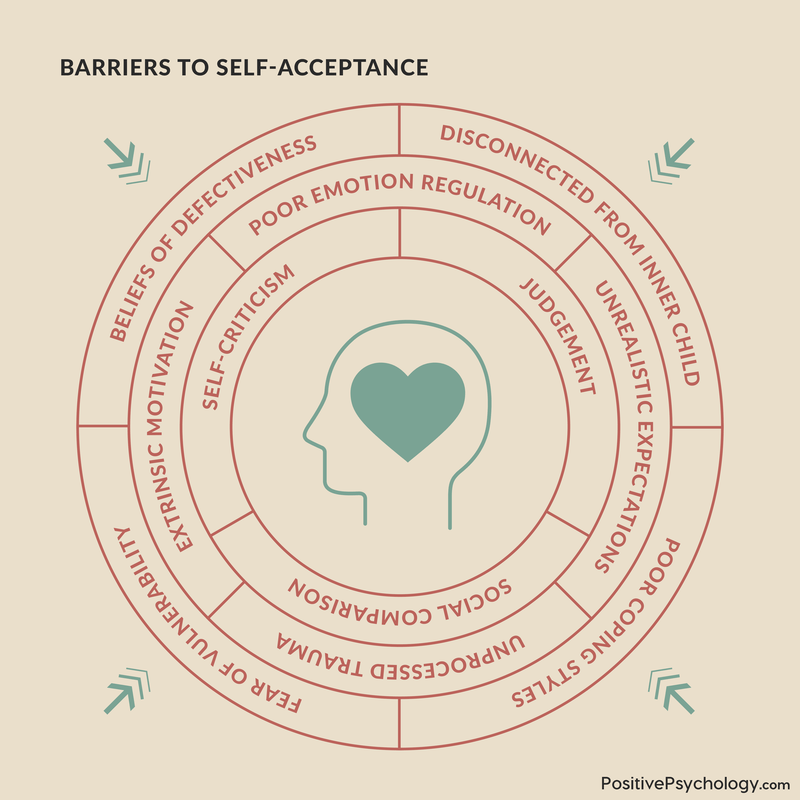
Are you ready to use ACT as a way to improve your life or the life of your clients? If so, read on for excellent resources to apply the science of Acceptance and Commitment Therapy to your work.
Many of these are made available by the organization ACT Mindfully, which is a great resource.
Follow this link for a PDF that includes several worksheets and lots of information on how to guide a client through them.
This worksheet is a fillable matrix on page 6 with one column for writing down triggers (situations, thoughts, or feeling that immediately precede a certain behavior), behaviors (what you actually do), and payoffs (the immediate outcomes of the behavior that encourage the behavior to continue).
This worksheet can help you or your clients identify self-defeating behaviors with the motivation behind them, which can be a first step to recognizing and modifying problematic behavior.
Another worksheet presents the Values Bull’s Eye, or a set of concentric circles that are separated into four quadrants: work/education, leisure, personal growth/health, and relationships.
The exercise involves placing an “X” on the circle that most closely represents how you feel in the present moment.
The closer to the middle the X is, the more you feel you are behaving like the person you want to be. The further out the X is, the less you feel like the person you want to be. This worksheet can be found in the PDF above on page 11 or individually here.
The final pages in the PDF from ACT Mindfully help you estimate your psychological flexibility based on three factors:
Here you will find a visual representation of psychological flexibility, an explanation of each of these three factors, and a method of estimating your abilities in these areas at this moment.
Another PDF packed with worksheets is provided by www.thehappinesstrap.com. This PDF can be found here, and includes these worksheets:
This worksheet present four sentences for you to complete:
Next, you are asked to write a list of everything you have done to try to avoid or get rid of these thoughts, feelings, sensations, and memories. Distracting yourself from these, avoiding activities, or using substances to self-medicate are a few examples of avoidance techniques.
Then you are asked to consider these questions for each item:
This worksheet can help you become aware of your own avoidance strategies, and whether they are producing the results you want.
This page introduces two simple mindfulness exercises for any typical day:
This worksheet allows space for you to imagine some informal mindfulness exercises to add to your day, such as while waiting in traffic or while walking from your car to your door. Maybe it’s as little as “no-phone” time while you grocery shop or wait in line.
The Values Assessment Rating Form provides a matrix with 10 life domains (e.g., couples/intimate relationships, parenting, employment, etc.) and 4 columns to fill out:
The Values Assessment Rating Form can help you identify where you are falling short of your goals and where you are meeting your goals, as well as aiding the prioritization of meeting these goals going forward.
This worksheet guides the reader through the values that underlie their goals and how to make sure these goals are SMART goals. SMART is an acronym for goals that are Specific, Meaningful, Adaptive, Realistic, and Time-bound.
This activity will help you understand how to set goals that you can meet, rather than lofty ideas that are not backed by concrete actions.
This informational page offers a practical and useful response for when you face a crisis.
This response is called STOP:
Here is a list of things to consider during this exercise:
For therapists and other mental health professionals, this PDF from The HappinessTrap aligns with ACT principles as well. It provides questions for you to assess your clients for their psychological inflexibility.
Psychological inflexibility is the extent to which anyone has trouble practicing the six core processes. The questions map to the opposite of the six core processes as follows:
This set of questions can be a great tool to help your clients ascertain where to focus their energy. This is a critical step to embracing their experiences and act according to their deepest values.
If you’re looking for a visual resource on how to apply ACT in your practice, check out this slide presentation on acceptance and mindfulness as therapeutic tools.
This presentation includes information on how mindfulness and acceptance can benefit people who are struggling. It also explores the theories behind how ACT works, along with suggestions for therapists who want to introduce their clients to mindfulness.

The section above includes several resources with Acceptance and Commitment Therapy practices, and now we’ll describe the most popular exercises and metaphors in detail=.
Several of these can be found on the Association for Contextual Behavioral Science website, on their ACT exercises page or their ACT metaphors page. For each exercise or metaphor, a link will be provided to the exercise for you to learn more.
This is a quick exercise for mental health professionals to help their clients understand how avoidance can be counterproductive. This exercise can be completed in the following steps:
You can find this exercise in more detail here.
This exercise can be guided by a therapist or completed on your own. Following these steps can help you or your client understand that suffering is an inevitable part of life; if we eradicated suffering, we would also eliminate joy.
Follow these steps to give this exercise a try:
For more information on this exercise and the story behind it, check it out here, and look here for a similar exercise from ACBS.
This is a mindfulness technique that can defuse a strong, negative emotion. Follow the steps to renew your focus on acceptance and positive action toward your values:
To read the entire technique description and try it for yourself, click here.
This exercise is a great first step for anyone looking to start practicing ACT techniques. Values, as mentioned earlier, are a foundational piece in Acceptance and Commitment Therapy.
The Valued Directions worksheet presents 10 value domains for the reader to consider:
The exercise then asks the reader to rate the importance of each value domain on a scale of 0 (not at all important) to 2 (very important). There is nothing wrong with valuing some areas more than others.
Then, readers rate their satisfaction with their lives in each area on a scale of 0 (not at all satisfied) to 2 (very satisfied).
Once the ratings have been completed, the exercise asks readers to review any value rated as a 1 or 2 on the importance scale and write their intentions in that area for the foreseeable future. In other words, write down what you want to achieve, maintain, or become in each important value area.
These are not goals that can be completed and “checked off,” but rather they are actionable goals that match how you want to live your life each day.
This exercise can help clarify what is important and needs to be prioritized in your life. It’s best if you have a therapist or qualified professional to discuss the results and actionable goals with. It is still a powerful exercise whether you are currently attending therapy or not.
To give this exercise a try, follow this link.
For more ACT exercises, check out the exercises, techniques, and worksheets on the following sites:
Metaphors also play a key role in Acceptance and Commitment Therapy. They provide clients with a simple way to understand how their feelings and thoughts influence their actions, and thus, allow people to visualize how adjusting our thoughts affects our behaviors.
Here are three of our favorite metaphors relevant to ACT.

This metaphor uses the setting of a small sailing boat, with “you” as the sailor.
Occasionally, waves send water over the side and into the boat, causing you the inconvenience of wet feet. The boat includes a bailer to bail out this water, and you know how to use it.
So one day, when a particularly big wave breaks over the side and leaves water in your boat, you start bailing. You may start bailing calmly or mindfully, but eventually, you might find yourself bailing desperately or wildly to get rid of all this water.
While you’ve been bailing, have you noticed what is happening to your boat? Where is it headed? Where has it drifted to? Would it be fair to say you’ve been bailing more than sailing?
Now imagine that you take a look at the bailer and see that it is really a sieve, full of holes? What would you do?
The implicit purpose of bailing water here is probably to get your boat back on track – once you rid the boat of the water. But if your tool is not suited to the task, you will find yourself struggling to get rid of any water, let alone guide your boat.
The question is would you rather be on a boat that has only a little water in the bottom, but is drifting without direction, or on a boat that may have quite a bit of water in the bottom but is heading in the direction you wish to go?
This metaphor can help you or your clients realize two things:
This metaphor can be accessed in its entirety, as part of the Positive Psychology Toolkit©.

The Positive Psychology Toolkit© is a groundbreaking practitioner resource containing over 500 science-based exercises, activities, interventions, questionnaires, and assessments created by experts using the latest positive psychology research.
Updated monthly. 100% Science-based.
“The best positive psychology resource out there!”
— Emiliya Zhivotovskaya, Flourishing Center CEO
This metaphor is meant for people struggling with a particular emotion or diagnosis, like anger, anxiety, or depression.
In this metaphor, the mind bully is our particular problem: it is an extremely large and strong bully. We are on opposite sides of a pit, tugging back and forth on a rope as the Mind Bully tries to make us fall into the pit.
When we pull on the rope, when we listen and pay attention to or even believe the monster, we are actually feeding it. Like any bully, the Mind Bully can only harm us when we engage with it and believe the negative things it says. In other words, don’t let your mind bully your body.
Instead of pulling on the rope, what do you think would happen if we drop it? The Mind Bully might still be there, hurling its insults and meanness, but it would no longer be able to pull us towards the pit.
The less that we feed the Mind Bully, the smaller and quieter it will get. Maybe eventually, we even will grow empathy for this sad creature and wonder why it says such mean thoughts.
We stop feeding the Mind Bully by noticing and acknowledging it but shifting our attention away from it instead of believing what it says. Engaging in a quick mindfulness exercise can be a great way to do this.
To learn more about the Mind Bully metaphor and read the alternate version of this metaphor, visit this website.
Quicksand is a loose, wet patch of sand that cannot support weight like dry sand can. When you step in quicksand, you start to sink instead of finding a solid footing.
Common knowledge is that struggling against quicksand only increases the rate at which it sucks you down into its depths. When you put more weight on one foot to try to lift the other, it just sinks deeper into the pit. The more you struggle, the deeper you sink. Frightening!
The solution to surviving quicksand is to spread your body weight over a large surface area and move slowly.
Rather than trying to stand and fight the quicksand, ignore your instincts to struggle and lie down on your back instead.
It’s counterintuitive, but the less you struggle and the more you accept your present situation and embrace vulnerability, the easier it is to escape.
This same principle applies to pain, suffering, and knowing when to ask for help. The more we struggle and fight against it, rather than accepting our situation, the more we drag ourselves down deeper.
When we accept that the suffering is inevitable, we are more likely to survive and come out the other side more quickly and efficiently.
To learn more about this metaphor, you can read about it here or watch a short YouTube video about it here.
If you find metaphors to be useful tools in your own life or your clients’ lives, you can read more metaphors in The Big Book of Metaphors: A Practitioner’s Guide to Experiential Exercises and Metaphors in Acceptance and Commitment Therapy by Jill Stoddard, Niloofar Afari, and Steven C. Hayes.
You can also visit these websites for quick and simple descriptions:
We also suggest a couple of videos on ACT metaphors in the YouTube videos section below. Spoiler alert: they include some pretty cute animation.
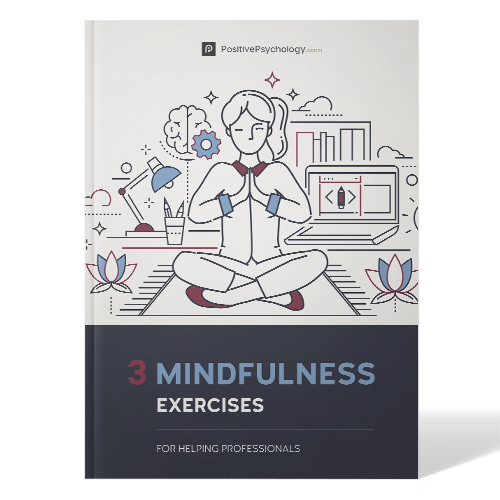
These detailed, science-based exercises will help you or your clients enjoy the benefits of mindfulness and create positive shifts in their mental, physical, and emotional health.
Download PDF
By filling out your name and email address below.
To learn about other Acceptance and Commitment Therapy training, visit this website to see upcoming courses, workshops, classes, and webinars. In addition, we have this article with 17 course options: Acceptance & Commitment Therapy Training.
In addition to the bonus book description – ACT for Dummies – we list three books highly applicable to get a good understanding of ACT.
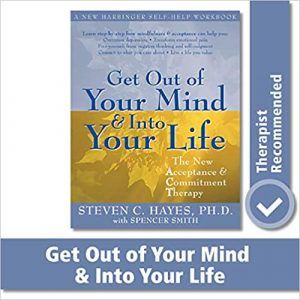
The most essential ACT book may be Hayes’ Get Out of Your Mind and Into Your Life. At one point, this book was a best-seller in the self-help family of American books.
This book offers an emphasis on accepting and living with pain, which is a concept largely foreign to the Western perspective on happiness and the avoidance of pain.
This book will walk you through the foundations of ACT and help you learn to accept your emotions rather than act in ways that are self-destructive or undermining to your mental health.
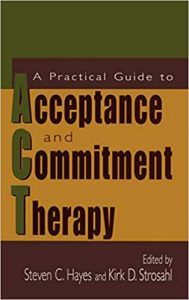
If you’re a therapist or researcher wanting to apply ACT in your practice or research, A Practical Guide to Acceptance and Commitment Therapy is great.
This book establishes the groundwork for integrating ACT into your work.
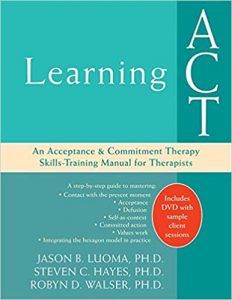
This book garnered numerous positive reviews on Amazon and includes a DVD that features role-plays of some of the main ACT processes and techniques.
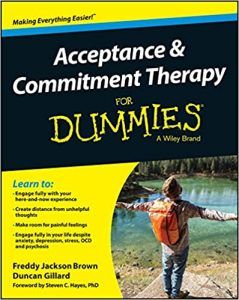
This book on ACT “For Dummies” is no different.
It describes what ACT is, how it can be applied to everyday life, and why it works.
Like the practice of mindfulness, ACT can be applied in any individual’s life and help with general anxiety disorders, chronic pain, depression, OCD, eating disorders, and social anxiety.
Many studies showcase the positive effects of this form of therapy for patients struggling with anxiety.
For example, one study showed that college students who received ACT treatment enjoyed less stress in regards to academic concerns, decreased anxiety and depression symptoms, greater general mental health, and improved mindful acceptance (Levin, Haeger, Pierce, & Twohig, 2017).
Another study reiterated these positive impacts on anxiety and showed that ACT delivered via the internet could be as effective as therapist-delivered ACT (Ivanova et al., 2016).
The participants in this study reported reduced general and social anxiety, whether they were in the “treatment as usual” group or the online ACT group.
To learn more about how to apply Acceptance and Commitment Therapy to anxiety disorders, check out this website that is packed with information on how ACT can help treat anxiety and why it works. This site focuses on important points like mindfulness, commitment, and control paradox, which arises from our expert ability to control our environment paired with our relative inability to control our thoughts and emotions.
If you want to treat anxiety with ACT, we recommend the following book, Acceptance and Commitment Therapy for Anxiety Disorders: A Practitioner’s Treatment Guide to Using Mindfulness, Acceptance, and Values-Based Behavior Change Strategies. This book can be found here.
Georg H. Eifert, John P. Forsyth, and Steven C. Hayes offer real and tangible changes for therapists and clients alike.
Acceptance and Commitment Therapy has been found to improve quality of life-even without affecting the level of pain experienced-for many cases of chronic pain.
One study showed that cancer patients who receive ACT treatment reported significant improvements in the acceptance of their circumstances and finding increased meaning in life, even while still experiencing pain (Datta, Aditya, Chakraborty, Das, & Mukhopadhyay, 2016).
Another study also found that ACT improves psychological flexibility and reduces depressive symptoms, even when chronic pain remains (Scott, Hann, McCracken, 2016).
A different study verified this finding, reporting that physical and emotional functioning improved with ACT, even with no concurrent reduction in pain (Vowles, Witkiewitz, Levell, Sowden, & Ashworth, 2017).
Similarly, ACT has been found to improve symptoms for people suffering from depression. One study found that ACT decreased the severity of depressive symptoms for veterans with depression and suicidal thoughts (Walser, Garvert, Karlin, Trockel, Ryu, & Taylor, 2015).
ACT also reduced psychological inflexibility and distress related to depression and anxiety in older adults, even with only a brief course from a novice ACT therapist (Roberts, 2016).
If you’d like to learn more about using Acceptance and Commitment Therapy to treat depression, give this book a try: ACT for Depression: A Clinician’s Guide to Using Acceptance and Commitment Therapy in Treating Depression, by Robert Zettle. It describes how ACT can contribute to the successful treatment of depression by providing a session-by-session approach.
ACT can also help patients suffering from Obsessive-Compulsive Disorder (OCD).
An overview of the quantitative research conducted in this area showed that ACT treatment for OCD is as effective as the “treatment as usual” approach, including cognitive behavioral therapy (Bluett, Homan, Morrison, Levin, & Twohig, 2014).
For a great explanation of how to apply ACT in the treatment of patients with OCD, check out Michael Twohig’s piece on this subject.
He explains that ACT can be applied to OCD treatment by viewing behaviors as changeable rather than inherent biological responses. He offers ways to focus on clients’ reactions to events, instead of seeing their behaviors as fixed facets of their personality.
Finally, ACT has also been successfully applied to patients with eating disorders. A case-series study on women with Binge Eating Disorder showed that participants improved with the application of ACT (Hill, Masuda, Melcher, Morgan, & Twohig, 2015).
One patient even reached a point where her symptoms no longer met the clinical definition of Binge Eating Disorder, while both displayed increases in their body image flexibility.
In a study on patients with anorexia, participants who received treatment that included ACT were more likely to reach positive outcomes at the end of the study (Parling, Cernvall, Ramklint, Holmgren, & Ghaderi, 2016).

Acceptance and Commitment Therapy can be applied on an individual level, but it is also effective when delivered via a treatment group.
The Association for Contextual Behavioral Science acknowledges the effectiveness of group ACT treatments for anger, depression and general anxiety, social anxiety, chronic pain, and for struggling adolescents.
The Houston Group Psychotherapy Society reiterates the effectiveness of group ACT therapy, noting that a group setting can provide opportunities for clients to connect and learn from one another, receive the validation they may desperately need, and practice constructive vulnerability.
The HGPS also lays out some advice for applying ACT in a group (learn more about group therapy here):
Set rules for the group (show up to each group ready to make it work, don’t try to “solve” another group member’s feelings, conversations within the group are not expected to continue outside of this context etc.) and make sure group members know they must be followed.
Decide on whether the group is more general or for a more specific topic like anxiety or depression. Consider starting the group with a mindfulness exercise or keeping a quick mindfulness exercise in your back pocket in case a group member gets off track.
Don’t be afraid to include experiential exercises but be on the lookout for judgment from group members after the exercise.
When conflict arises, which is likely to happen at some point, guide the group member to their inner experience first. Help them bring their thoughts back to making therapy work for them. Be ready to experience discomfort. Avoid the urge to “rescue” group members from their pain. As some therapists say, “don’t steal the struggle,” as it is sometimes a key part of the group’s process of establishing trust for each other.
For more information on applying ACT in groups, see the humorously named The Idiot’s Guide to ACT in Groups. This workbook provides a practical outline for setting up and conducting group ACT therapy and includes models, techniques, exercises, and basic protocols for group ACT.
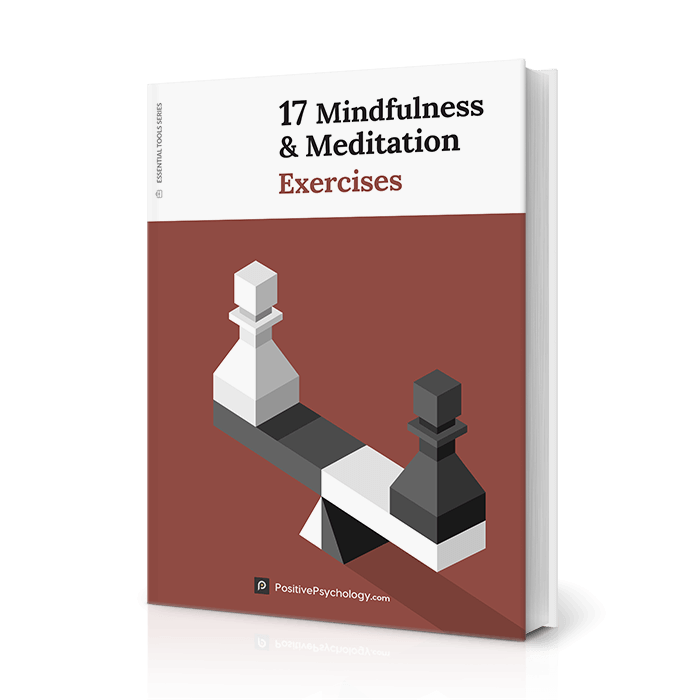
Use these 17 Mindfulness & Meditation Exercises [PDF] to help others build life-changing habits and enhance their wellbeing with the physical and psychological benefits of mindfulness.
Created by Experts. 100% Science-based.
If you learn more efficiently from videos than books, then here are some fantastic ACT videos on YouTube to learn more about ACT techniques.
For a great overview of ACT videos, begin with Dr. Russ Harris’ YouTube channel here. He has several ACT videos for different audiences and techniques. For example, one upload is for specifically for adolescents who want to harness ACT to “stop struggling and start thriving.”
If you’re looking for a short and sweet introduction to Acceptance and Commitment Therapy, the video below comes from the Veterans Health Administration.
If you’d like to learn more about the metaphors applied in Acceptance and Commitment Therapy, this video from Joe Oliver explains the ACT metaphor of passengers on a bus. In this metaphor, we are asked to place ourselves in the role of the bus driver, the person who has control over the speed and direction of the bus, but not the passengers.
Just as we cannot control the passengers who board the bus, we cannot control our own internal experiences, but we can allow them to say their piece while maintaining control over the bus. It’s only five minutes and features engaging animation.
Another great video from Joe Oliver outlines the unwelcome party guest metaphor. This video is just over four minutes and shows how trying to avoid things can backfire. Instead of avoiding the negative experiences that cause us stress or emotional discomfort, allowing ourselves to experience them and learn from them can produce far better results.
What if our depression, or anxiety, was “that unwelcome party guest” we should allow space for at the party?
Our final metaphor video from Joe Oliver images one of the demons on the boat. In this metaphor, we are steering the boat with a horde of angry, aggressive, and intrusive demons in the water below us. If you’re wondering how this translates to helpful ACT tactics, watch the video below.
You may be entertained and surprised.
Which of these videos resonates best for you? When you finish this article, we would love to hear from you in our comments section.
As technology flourishes, so do the set of treatment options available to us. As with so many other problems, issues, or opportunities, there’s an app for that!
The two most popular apps are described below.
The ACT Companion App, or the Happiness Trap App, is very popular. It is from Dr. Russ Harris and psychologist Anthony Berrick. If you are unfamiliar with Dr. Russ Harris’s project, this video below may inspire you towards applying ACT to your life or practice.
The app that Dr. Russ Harris designed helps you keep your commitment to positive action through mindfulness exercises. One tool measures how well you applied ACT skills to real-life situations, and prompts quick mindful acts.
This app is available through Google Play for $9.99 and the Apple App Store for $14.99. It’s not free, but it is a relatively inexpensive investment for an app that can help you dramatically improve your quality of life.
If you are interested in downloading this app, click here to learn more.
This app is offered through the US Department of Veterans Affairs. It includes tabs such as “Learn,” “Practice Mindfulness,” “Live Your Values,” and “Track Your ACT Moments.”
This app is designed to help veterans live their values in their daily life, even when faced with unpleasant situations and potential PTSD. It is available at no cost through iTunes. You can learn more about this app here.
Acceptance and Commitment Therapy has the potential to produce extremely positive results, and not only for those suffering from psychological disorders.
If you are suffering from the pain inherent in everyday life, or you know clients and other people who do, this form of therapy has been highly successful. With so many resources available online, it’s easier than ever to give ACT a try.
Whether you want to try it yourself or guide your clients through ACT, I hope this piece has provided you with the information and resources you need to get started.
Thanks for reading.
And please, leave a comment below. Have you ever tried Acceptance and Commitment Therapy, for yourself or your clients? We would love to hear more.
We hope you enjoyed reading this article. Don’t forget to download our three Mindfulness Exercises for free.
ReferencesCourtney Ackerman, MA, is a graduate of the positive organizational psychology and evaluation program at Claremont Graduate University. She is a researcher and evaluator of mental health programs for the State of California and her professional interests include survey research, wellbeing in the workplace, and compassion.

Share this article:
Very helpful overview- I only have opened a couple of the links so far but am VERY appreciative of the thoroughness in your compilation! Reply
Lisa D on June 4, 2023 at 05:10You claimed I could download three mindfulness exercises for free. However, I was led to a site that requested a $100 payment. Thanks for reinforcing negative thoughts. Very disappointing Reply
Julia Poernbacher on June 4, 2023 at 16:30Hi Lisa, I apologize for the inconvenience and frustration you experienced. I notified the team to ensure the link directs to the three complimentary mindfulness exercises. In the meantime, please use this link to access the three mindfulness exercises. I hope this helps!
Kind regards,
Julia | Community Manager Reply
I live in southern California, who can I contact to begin therapy, and will it be covered by my insurance? Reply
Caroline Rou on November 7, 2022 at 12:43Hi Donna, Thanks for your question. As we are not based in the California, it is difficult for us to make recommendations for reliable therapists. I suggest you look for a therapist directory in your area and filter your search. Insurance coverage varies per situation. I hope this helps 🙂 Kind regards,
-Caroline | Community Manager Reply
ACT is right if you go a bit ‘Radical’! Acceptance and Commitment therapy has been validated mainly through correlational studies between groups that use ACT and those that don’t, or ‘between group’ designs, that unfortunately leave a lot of room for debate for the relative efficacy of alternative therapies such as CBT and other talk therapies. Here is a validation from a ‘within’ subject design (mapping behavior to actual brain processes) that maps the concepts of acceptance and commitment to bio-behavioral events, or a radical behaviorism. It does not engage the complex syntactic structures of relational frame theory, and is therefore quite simple. A Commitment to Values works, but best while in a resting or relaxed state. Here is why. Positivity Simplified
Persistent positive or meaningful thinking in a resting state will increase pleasure and arousal, and avoid negative ideation that elicits opposing emotional states. Positivity Explained
Any relaxation protocol from eyes closed rest to mindfulness is pleasurable, due to the release of endogenous opioids. If concurrent persistent positive or meaningful ideation occurs (meaning is defined as thinking of or doing actions that have branching novel positive implications, or virtual positive act-outcome contingencies), this induces a feeling of arousal as mediated by dopamine systems. Dopamine and opioid systems are synergistic, or when activated simultaneously reciprocally stimulate each other, causing feelings of greater pleasure and arousal, or ecstatic states. This explains why ‘loving kindness’ meditation, savoring, peak, or flow experiences that have rest as an entailment ‘feel’ different from resting states, yet nonetheless represent unremarkable and simple neural processes that can be explained and replicated with ease by anyone. An Aside on ACT
Ironically, this procedure may be termed ‘relaxation and commitment’ in contrast to ‘acceptance and commitment’, as relaxation protocols by design involve the avoidance of negative ideation or an ‘acceptance’ of the status quo. The difference is that the former derives from a radical or bio-behaviorism, while the latter derived from a behavior analytic theory of language. A formal explanation from a neurologically based learning theory or ‘radical behaviorism’ of this technique is provided on pp. 44-51 in a little open-source book on the psychology of rest linked below. (The flow experience is discussed on pp. 81-86.)
https://www.scribd.com/doc/284056765/The-Book-of-Rest-The-Odd-Psychology-of-Doing-Nothing The Psychology of Rest, from the International Journal of Stress Management, and from the Journal ‘The Behavior Analyst Today’ by this author
https://www.scribd.com/doc/121345732/Relaxation-and-Muscular-Tension-A-bio-behavioristic-explanation
https://www.scribd.com/document/16384355/Stress-and-the-Cinderella-Effect More on Neurologically Grounded Learning Theory- Berridge Lab, University of Michigan
https://www.scribd.com/document/447163649/Berridge-Reward-Learning-Incentives-and-Expectations
and The Psychology of Incentive Motivation and Affect (for a layman’s version)
https://www.scribd.com/document/495438436/A-Mouse-s-Tale-a-practical-explanation-and-handbook-of-motivation-from-the-perspective-of-a-humble-creature Reply
Please explain how Acceptance and Commitment Therapy works. I am trying to do a presentation for my mom to look at (of course) so that then she can learn about what Acceptance and Commitment Therapy is and how it works and many other topics about Acceptance and Commitment Therapy. Reply
Nicole Celestine on February 1, 2021 at 04:53Hi Shawn, In addition to the details throughout this article, professional ACT trainer, Dr Russell Harris, has a great little PDF handout that succinctly explains the process and benefits of ACT, which applies many of the same principles of mindfulness. You can download that here. 🙂 Hope this helps! – Nicole | Community Manager Reply